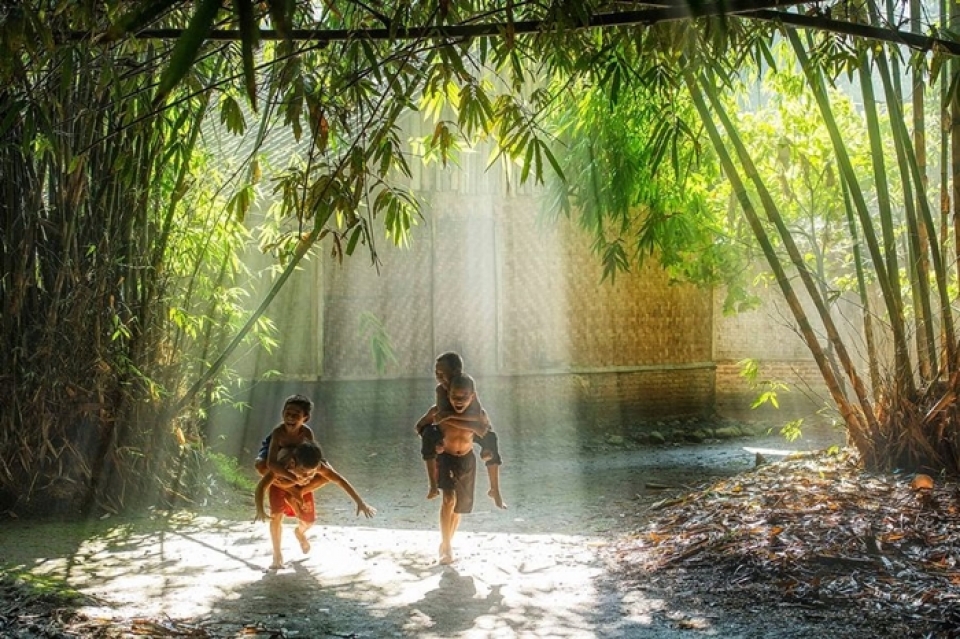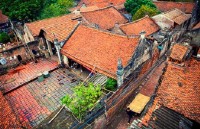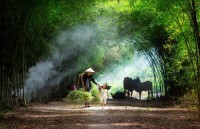
My village
Latest
| TIN LIÊN QUAN | |
| A contribution to human happiness: Pho | |
| The trees of Ha Noi | |
I shall never forget this lesson learnt by heart at primary school when I was eight:
My village
“My village is surrounded by a bamboo hedge which hides its houses from view. One enters it through a brick gate. Most houses are thatch huts. Each house, encircled by a bamboo hedge, has a courtyard, a garden and in many cases a pond. In the garden, there grow vegetables, sweet potato, and fruit trees. Besides a little road crossing the village there are only narrow lanes. For some time now, they have been paved with bricks, which has made them cleaner. Formerly, whenever it rained, it was very unpleasant to use them because one had to walk in the mud.” [1]
To complete the picture, one must add the presence of the market, the communal house, the pagoda, the small open-air shrines dedicated to Confucius and prominent scholars (văn chỉ) as well as to various spirits.
The bamboo hedge, in some cases reinforced by an earth embankment and a moat, turns the small rural community into a green islet in the middle of a sea of rice fields. It protects the villagers against bandits as well as typhoons, and supplies materials for the repair or construction of temples, bridges, markets and other public works. It usually has four gates (north, south, east, west), sometimes fewer, which are closed at nightfall by guards. Before the main entrance, banyan or ceiba trees cast refreshing shade where farmers returning from the fields or travelers can rest while drinking a cup of tea at a stall nestled among them.
 |
| Illustrative image. (Photo: Thuvienanhdep.net) |
One may visualize in this way a village in the delta of north Vietnam, the cradle of the nation. It has kept many of these traditional traits in spite of changes brought about by western influence and urbanization. Topographically, there are four types of villages. The riparian village generally stretches behind the dyke, which serves also as a road, on a higher level than the rice fields around them. It is often submerged by floodwaters, especially if it is located between the river and the dyke.
The village in the swampy lowlands extends between the major stream and its effluence, is built on raised ground for in the flood season the fields are under water.
The village in the uplands is built on a hill slope near a river or forest stream. Here the population is sparse, the land not very fertile.
The coastal village sits on or among sand dunes. The sandy land had been turned into arable land. The dense population owns relatively big houses with garden and orchard.
The topography of the different types of villages is determined by the cultivation of wet rice in submerged fields which had forced the Viet (the majority ethnic group in Vietnam) to leave the piedmont to settle in the plains.
In their southward advance - as far as the Mekong delta in the 17m century - the Viet villages had dispersed.
The southern Village (in the Mekong delta), although born of the northern village (in the Red River delta), has, through a kind of mitosis, become different from it in many respects. Going into sparsely populated wild regions, the first settlers - famished peasants, soldiers of farming colonies, adventurers, and political refugees from China - began by establishing themselves on raised stripes of alluvial land (con giồng) before building new villages on low-lands along the multitude of channels, called “arroyos” by the Spanish. Most boo hedges, were not isolated from each other, and were often quite close together. Compared with northern villages, they were young communities, and had a heterogeneous population, including Chinese, Cham and Khmer minorities. The people are not bound by strict age-old traditions. Fertile land and mild climate spare them the toil and suffering which have for long been the lots of their brothers in the Red River delta. All this led to a “southern” mentality, with which we shall deal with later on.
Huu Ngoc
[1] Quốc văn giáo khoa thư (Primer for the second grade) published by the Education Department of French Indochina, 10th edition, 1935. The first edition came out in the 1920’s.
 | Stunning images of traditional pottery village Apart from orchards, the southern province of Vinh Long has attracted a large number of tourists to its traditional pottery village. |
 | Traditional and French-style architecture in Cu Da village Located 20 km west of Ha Noi on the bank of the Nhue River, Cu Da is one of the few villages in Vietnam that ... |
 | Vietnam through lens of Zing photo contestants From the gorgeous winding rivers of Vietnam to peaceful village settings, the moments and places captured in this year's Zing.vn Photo Contest are nothing short ... |
















